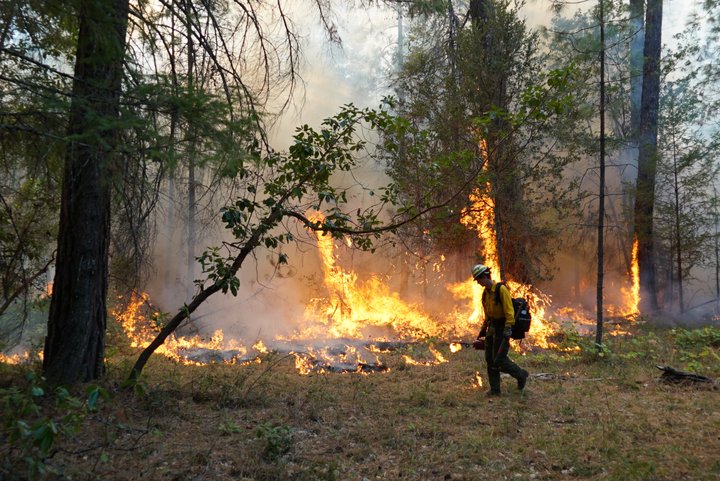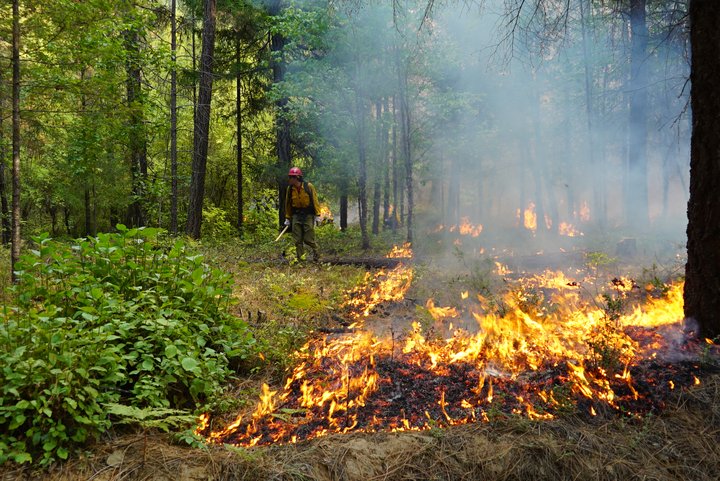
A 2021 Klamath TREX participant. | Photos: Eric Darragh
###
The season is turning. It’s time for prescribed fire, the good fire that helps prevent wildfires.
Around here, a lot of prescribed burning — intentionally introducing controlled fire to the landscape in order to reduce fuel come next wildfire season — happens through the annual Klamath River Prescribed Fire Training Exchange (Klamath TREX), a “learn and burn” training event. With 150 participants and several areas ready to burn, this year’s Klamath TREX, already underway, is the largest prescribed fire training in the United States, its organizers say.
In fact, “the middle Klamath has really emerged as sort of this epicenter of a national movement around prescribed fire and cultural burning,” Craig Tucker, a natural resources policy consultant with the Karuk Tribe, said at a Klamath TREX media briefing.
Why? “Because that’s where the Karuk Tribe is,” Tucker said.
Fires intentionally lit by Indigenous peoples burned through landscapes for thousands of years before the development of state and federal laws and regulations largely stamped those practices out. Beyond protecting watersheds and their people from wildfires, tribes used fire because it helps ecosystems thrive.
“We’ve got a very significant and long-lasting relationship with fire here in our Aboriginal territory,” said Bill Tripp, Karuk Tribe natural resources director. “Our creation stories talk a lot about how our relationships formed with plants and animals and ecological processes, such as fire.”
Seasonal prescribed burning helped protect wooden houses and structures in Karuk country, Tripp said, but it’s always been about more than just that.
”Frequent low- to mid-severity fires help to maintain habitat dynamics out there to support biodiversity and helps to create food for the plants and animals that are also our food. And so, in us helping to feed them, they, in turn, feed us.”
Prescribed burning stabilizes staple Karuk foods salmon and acorns, Tripp said. Burning removes small vegetation that uses surface water, which increases flow, and the smoke in the air reduces water temperatures — both of which are beneficial to salmon, Tripp explained. Burning at the right time can prevent bugs from infesting next year’s acorn crop, which supports animals relying on that food source, too. And burning supports other cultural practices, like basket weaving, by making the materials pliable.
“It’s kind of a circular economy out there, and a socio-ecological system, and the humans are part of [it],” Tripp said.
Today, cultural and prescribed burning are being steadily revived, but despite the known benefits of prescribed burning — potentially reducing damage and spread come inevitable wildfires — it continues to face barriers in the form of permitting and regulation setbacks.

TREX events manage to comply with current legal structures.
Originally developed by the Nature Conservancy, an environmental nonprofit, TREX has grown into about 15 annual trainings around the United States. The trainings are typically joint-hosted by several local, state and federal organizations; Klamath TREX alone is supported by more than a dozen partners, like the Mid Klamath Watershed Council, Salmon River Restoration Council and Cultural Fire Management Council.
The training shares intergenerational knowledge about how to bring fire to the landscape in a good way, during times of the year when it’s safe, said Erica Terence, public information officer for Klamath TREX.
Prescribed burning must fall within a delicate window: after the first rains of the season, which dampen the landscape enough to make it safe to burn, and before the later, heavier rains, which make the duff and vegetation too wet to catch.
Klamath TREX is usually two weeks long, but this year it will run all of October and into November, for seven weeks, and participants will come and go in two-week shifts. Trainees must take a 40-hour fire course before TREX, and by the end of the training, they wield the flame.
“We do have a labor shortage here in the middle Klamath to pull off these burns,” Tucker said. “And so in exchange for folks here in the middle Klamath sharing this information, we’re getting a temporary large workforce to help us put these burns on.”
The seven-week training length is exciting, Terence said, because it means they’ll be able to capitalize on the burn window in different areas as they come along. Organizers plan to burn areas on Karuk, private and public lands in and near Happy Camp, Somes Bar and Orleans. They’re working on burning piles (material that is the result of forest management), and broadcast burning, which is burning landscapes that do not have a forest canopy.
The training attracts participants from all over the world. Some people return multiple years because they like Klamath TREX so much, and many have told Terence that its focus on cultural resources sets it apart from other TREX events.
“The partners that host TREX are able to share out knowledge about how to reintroduce fire in your home territory. And so many people, especially tribes, are taking that knowledge back and working on doing that where they come from,” Terence said.
A big part of Klamath TREX is simply getting comfortable with fire. “There’s a lot of fear of fire out there,” Terence said. “We’ve been putting fires out for so long that part of it is just getting a chance to do it (prescribe burn) hands-on. Hold the torch.”
Fear of fire continues to hinder organizations and groups who are interested in burning more. The Karuk Tribe hopes to one day manage their million-acre aboriginal land with fire the way their ancestors did, Tripp said. A decade of catastrophic wildfires have shown that the stakes are high.
The Good Fire Report, a paper outlining cultural burning barriers published by the Karuk Tribe, says that air quality permits, burn permits and environmental review interfere with tribal sovereignty over controlled burning, and calls for agencies to establish stronger relationships with tribes in order to move prescribed and cultural burning forward.
California is working on it. This year saw a few major bills pass that will loosen restrictions on prescribed and cultural burning. The legislation requires the California Department of Forestry and Fire to appoint a cultural burning liaison, aids with burn bosses’ training and certification and makes it easier for agencies to buy insurance for burn projects. Additionally, California’s 2021-22 budget package allots $20 million to tribes working on prescribed and cultural burning.
But more is needed, Tripp said. “In order to really scale up, which is what we need to do to enact meaningful change, we have to address (additional) policy barriers,” he said.
Furthermore, “if the public doesn’t support it doesn’t happen,” Tripp said, but that’s not the case around here. Folks are thankful for the burns, which makes the middle Klamath the perfect place for a pilot prescribed fire training center that could be led by the Karuk Tribe and its partners.
“This is a good thing,” Tripp said. “It’s going to be the solution to the major problems that we’re seeing today.”

CLICK TO MANAGE